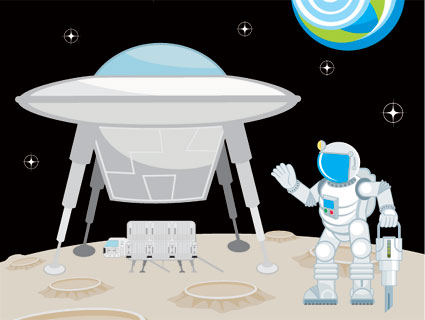
SETI has traditionally focused on looking for signs of life by scanning the skies for electromagnetic radiation. Above, a false-color view constructed using infrared data from the Spitzer Space Telescope of the Orion Nebula.<a href="http://apod.nasa.gov/apod/ap110917.html">NASA</a>
This story originally appeared on Slate and is republished here as part of the Climate Desk collaboration.
Humans are affecting the Earth’s systems on a global scale. Industrial pollutants are accumulating in our atmosphere with the potential for long-term impact on global climate and biodiversity. This is a story we are all coming to know well. However, there is now a new twist to the unanticipated consequences of anthropogenic climate change. In the distant future, industrial pollution—a sure sign of our technological activity—could potentially be detected from hundreds of light years away. Might extraterrestrial civilizations one day discover us by our pollution? Conversely, if aliens are anything like us, might we detect the existence of extraterrestrial civilizations by their pollution?
The search for extraterrestrial intelligence, more popularly known as SETI, has traditionally focused on looking for signs of technological activity by scanning the skies for electromagnetic radiation, such as radio waves. In other words, SETI research is typically focused on attempting to intercept the conversations of extraterrestrial civilizations. Thus far, over the 50-year history of SETI, we haven’t come up with any evidence for extraterrestrial intelligence, or ETI for short. Many have noted that this negative result doesn’t mean ETI isn’t out there: With an estimated 200 billion stars in our galaxy, there is a lot of territory to cover.
However, it might also be that we aren’t looking for the right signs of technological activity. The idea of searching for electromagnetic transmissions was first popularized when radio was our primary form of communication and Earth was therefore “radio loud.” But as we’ve moved on to digital communications, we are now becoming a radio-quiet planet. This leaves only about a 100-year window within which any extraterrestrial civilizations might detect our presence by our radio emissions. While 100 years may sound like a long time, on the scale of the cosmos, it is hardly the blink of an eye. If extraterrestrial civilizations are anything like us, their technological maturation may go through a similarly brief period of intense radio transmissions before going radio silent. The galaxy could therefore be ripe with short (approximately 100-year) flashes of radio noise pollution from technological civilizations in their infancy, each quickly snuffed out by rapidly advancing technologies. The challenge of detecting this phase of technological development is that we have to catch it in the act. It is therefore worse than looking for a needle in a haystack, as we must account for the short time such a signal could be produced against the backdrop of the billion-year history of our galaxy.
Henry Lin and collaborators at the Harvard–Smithsonian Center for Astrophysics have now proposed an alternative method for doing SETI. In a recent paper they suggest we hunt for signs of ETI not by looking for noise pollution, but instead by looking for industrial pollution in the atmospheres of alien worlds. Industrial pollutants are potentially longer lasting, so we have a higher probability of finding them. We are currently pumping pollutants known as chlorofluorocarbons into our own atmosphere as a byproduct of our technological activity. CFCs are a good candidate for detecting industrial activity, as they are not produced by natural sources. Additionally, searching for industrial pollution expands the window of time that we could detect ETI. Some CFCs have a lifetime of decades while others will be detectable for thousands of years. Detection of a short-lived CFC in the atmosphere of another world could therefore indicate an industrially active civilization—much like our own, while longer-lived CFCs would indicate that a polluting civilization existed sometime within the last 10,000 years or so.
Astrobiologists are already setting their sights on discovering life beyond our solar system by detecting biosignatures (evidence of past or present life) in the atmospheres of exoplanets orbiting other stars. So looking for technosignatures (evidence of past or present technology) is not too far off. Exoplanets are being revealed in increasing numbers thanks to the Kepler Space Telescope and other “planet hunting” missions. Many are terrestrial planets that could harbor conditions favorable to life. On such worlds, the presence of molecular oxygen, combined with a reducing gas such as methane, could be a telltale sign of life (both gases are primarily a product of biological activity on Earth). While a combination of these gases would be evidence of microbial life on another world, the detection of CFCs would be interpreted as a sign of advanced life.
Lin and his collaborators think that this kind of search could be conducted in the near future. By their calculations, the James Webb Space Telescope, currently set to launch in 2018, could detect CFCs at levels 10 times that of Earth. The caveat is that this could only be done for a planet orbiting a white dwarf star. (White dwarfs result from the death of a star like our sun.) Next-generation instruments could detect such signals for planets in systems more like our own solar system.
The idea of looking for the waste products of alien civilizations is not entirely new. Closer to home, SETI researchers have previously proposed that if advanced civilizations have in fact ever visited our own solar system, we might find evidence of alien “garbage”—i.e., leftovers from mining or observation missions. A good place to look for these artifacts is the moon. Since the moon lacks the rampant geological, and biological, activity of Earth, alien artifacts would be preserved for much longer on the moon than on Earth. Any alien space trash, mining equipment, or other tech left on the moon in the distant past could therefore still be evident on its surface.
The potential to discover alien industrial pollution or space trash provides promising new directions for SETI. However, it is an open question whether such a discovery would truly be a sign of intelligent life. In the words of lead author Henry Lin, “perhaps civilizations more advanced than us, with their own SETI programs, will consider pollution as a sign of unintelligent life since it’s not smart to contaminate your own air.” More than anything, this approach represents an important aspect of our search for extraterrestrial intelligence, which is that often our methods to search for ETI are an intimate reflection of ourselves. Hopefully we will one day enter a phase of human technological development where we will possess the insights to look for “greener” little green men.















